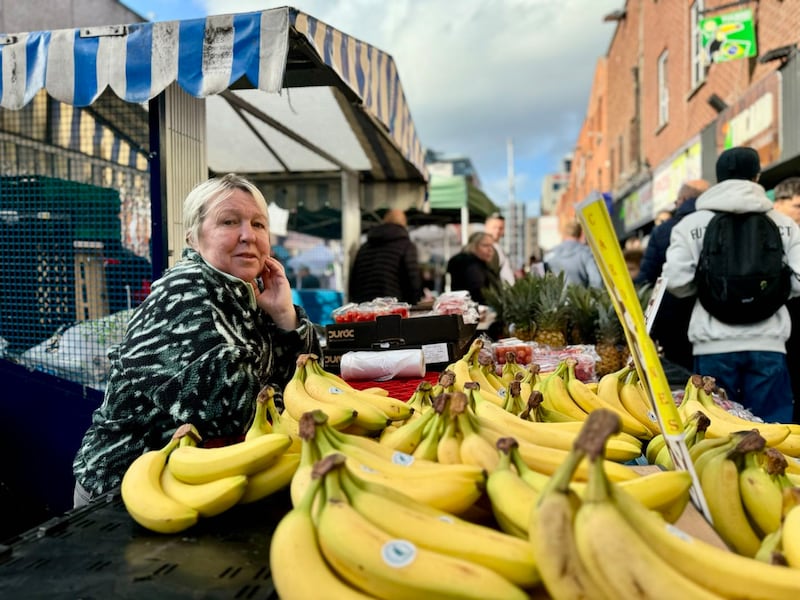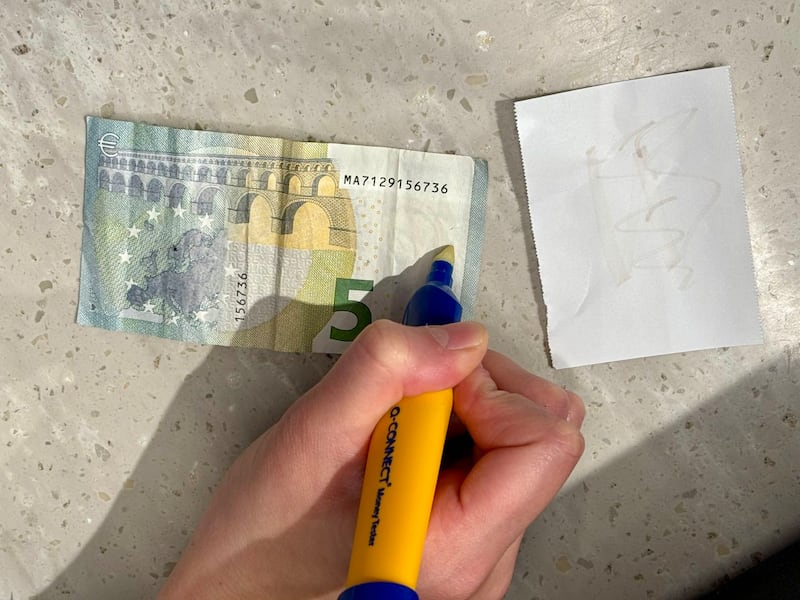In a small Indian shop on Moore Street, Dublin, four counterfeit banknotes are displayed, one with the word “fake” written in black ink, as a warning to potential fraudsters that the retailer knows dud notes are in circulation.
“There are so many people now these days bringing fake money. I have here with me four notes: 50, 50, 20 and 10, which I display,” says the shop owner.
The Indian businessman, who wants to remain anonymous, calculates he “lost a couple of hundred” euro as a result of dud notes.
The most recent attempt to pass counterfeit money in his shop was, he says, by a child “around nine to 10 years old. He brought a €50 note, and he wanted to buy one bottle of water, and he gave me the €50 note. When I looked at it, I said: ‘Wait, I will call the guards’.’ Then he ran away”.
READ MORE
He believes fraudsters target “small shops”.
“They target us ... And particularly those guys are coming to us due to our black colour. These are targeting our Asian shops. They know that we are not able to do anything,” he says. “They feel they are untouchable.”
Asked whether he notified gardaí, he said: “They’re not coming, they are very busy.”
While gardaí urge people to be vigilant for fake notes, traders on Moore Street including vendor Caroline Alwright point out there can be “very good counterfeits. Just too good to identify”.
For more than 40 years she has sold fruit and vegetables on the street and she is convinced there is an increase in the amount of counterfeit money in circulation in Dublin. “It’s a trend now ... in the last couple of months we’ve witnessed that ... a lot of people trying to pass it around. Now we’ve got caught a couple of times. They just pass it and then go off about their business and come back again and try again,” she said.

Despite her long experience dealing with all kinds of people on the street, she was deceived by a man pretending to be a merchant. “I got €100 from a fellah who spent €10 with me. He seemed genuine enough. He said he had a shop, and he was buying stuff for his shop. So, I just took it as genuine, but unfortunately it wasn’t,” she said.
The counterfeit note was given to gardaí, but “the guards said there’s nothing they can do. They took it. That is all. So I lost €90 euros. Now I don’t take €100 any more. I don’t take €50 any more. I just say: ‘No, you have to go somewhere else and change it’”.
The Irish Times spoke to workers and owners at 25 shops, cafes, markets and pubs in central Dublin and just four said they had not come across anyone attempting to pay with forged notes over the past six months.
Gardaí confirmed, in a statement, that there have been an increased number of reports of counterfeit currency this year.
“Counterfeit currency has seen an increase in 2024 with over 700 incidents reported so far this year, from January to October, compared to approximately 130 incidents in the same period in 2023,” said the statement.
The most common denominations of counterfeit banknotes detected are €50 notes, followed by €20 notes, it added.
A fraudster used bogus €50 notes to con a cashier at Sugar Loaf bakery on Lower Dorset Street on two consecutive days. “We received a €50 note one day, and another the next. The same person came back the following week and we refused to accept it. They always do the same thing. They want to buy something very cheap with a big note,” said the business owner, Fabiano Mayor.
“They try to give us fake notes when we are very busy in the shop because they see we are busy and think we are not going to check the notes,” said Fabiola Escalera, attendant at a fast-food business in the GPO Arcade on Henry Street.
In 4Fpizzeria, Dublin 1, a scammer successfully got the cashier to exchange a replica €50 on a busy day. “I was too busy. He came back one or two more times with a counterfeit €50 bill, trying to buy something very cheap, a coke, a cake, something, to get the change,” said supervisor Arthur Hubner.
In a shop nearby, the same scammer was filmed trying to pass the counterfeit notes, but cashier Carlos Santos noticed they were not genuine. “The guy is all dressed in black. He’s kind of in a hurry. He asked me to exchange the money. I said I wouldn’t exchange it because when he showed me the bill, I saw that the note was very, very, very weak, without colour. It was not real. I took a picture of the note and sent it to my managers. They verified that the bill was, in fact, not original. I told him that I wouldn’t make a sale, and he left the establishment,” he said.
At La Rocha restaurant, two swindlers not only enjoyed the hustle and bustle, they also flirted with the barista to deceive her and pass a bogus note. “They used the charm with me, saying: ‘Oh you are very pretty!’ Then they took a €50 note and gave it to me and bought a sweet ... When I went to put it in the cash register, I looked at the note again. I said: ‘there is something wrong’. Then when I realised it, I ran after them. They ran out into the street. Luckily, there was even a customer who saw them and took the sweet in his hand, but they left very quickly,” said barista Vivyan Gondin.
Not all fraudsters run when caught, however. Ms Escalera has seen some get aggressive when confronted. “It happened to me. I told them: ‘I cannot give you the note back because it’s fake’. And they started yelling at me: ‘Why are you saying that? It’s not fake!’ They get really aggressive and make a mess in the shop. Sometimes they throw things in our faces. Thank God we have that plastic screen on the till so they cannot get close to us,” she said.
Delivery man and rickshaw driver Felipe Carvalho, who was at the receiving end of a fake €20 note, was shocked recently when he saw one profile online advertising the sale of counterfeit notes. The price list ranged from €250 for €2,500 in counterfeit notes, to €800 for €8,000 in bogus bills.

Gardaí said organised crime plays a significant role in the production and distribution of counterfeit currency. “An Garda Síochána continues to liaise with other law enforcement agencies as part of Operation Decoy which is a joint customs and police operation aimed to disrupt the distribution of counterfeit currency via postal services around Europe. This operation is aimed at enhancing security and combating organised crime,” a spokesman said.
According to the Criminal Justice (Theft and Fraud Offences) Act, 2001, an individual commits an offence if they give a counterfeit item to someone with the intention that it be passed off as real, or if they attempt to pass something they know to be fake as real money. If convicted, they risk up to 10 years in prison, a fine or both if they pass or intend to pass counterfeit cash. They risk a fine, up to five years in prison or both if they deliver counterfeit money.
Gardaí have urged business owners and their employees to stay alert for counterfeit bank notes in all denominations. They say if a suspicious note is presented, retain it and notify gardaí.
“Business owners should be particularly mindful if someone is attempting to pay for an inexpensive item with a large note in an attempt to get a large sum of change in real money,” say gardaí.
Even though shops are investing in money-checker pens, which leaves a dark mark when used on a fake note, Ms Alright feels businesses are at risk due to the amount of forged notes in circulation. “It’s interfering with this shop here, the shop next door. It’s terrible”.

How to check whether a euro note is genuine
To check whether a euro note is genuine you should follow these steps, say gardaí.
Feel: The note is made out of cotton and should feel crisp and firm. The ink is raised, if you run your finger across the note the ink will feel thicker in parts.
Look: Check for a security tread, which will also state the numeral value of the note. Hold the note against the light to see the watermark and the numeral value.
Tilt: When you tilt the note you will see a hologram, which will also show the value of the note. On the back of the note the colour of the numeral value will change from purple to olive green to brown on the €50, €100, €200 or €500 notes.
Check: Check the note under UV light, whereby small fibres embedded in the paper will illuminate. Each note should have the signature of the president of the European Central Bank. The value of the note appears in the watermark, the security thread and in the hologram.
- Sign up for push alerts and have the best news, analysis and comment delivered directly to your phone
- Find The Irish Times on WhatsApp and stay up to date
- Our In The News podcast is now published daily – Find the latest episode here



















